Name Simko Shikak | ||
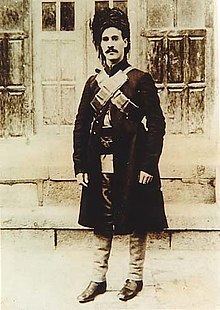 | ||
Similar People Shimun XXI Benyamin, Reza Shah, Colonel Pessian, Kuchik Khan, Mohammad Reza Pahlavi | ||
shorshi simko shikak 19 6 012 P1
Simko Shikak (also known as "Simitquh"; born Ismail Agha Shikak 1887 – 1930) was a Kurdish chieftain of the Shakak tribe. He was born into a prominent Kurdish feudal family based in Chihriq castle located near the Baranduz river in the Urmia region of northwestern Iran. By 1920, parts of Iranian Azerbaijan located west of Lake Urmia were under his control. He led Kurdish farmers into battle and defeated the Iranian army on several occasions. The Iranian government had him assassinated in 1930. Simko took part in the massacre of the Christians of Khoy and instigated the massacre of 1000 Christians in Salmas.
Contents
- shorshi simko shikak 19 6 012 P1
- Seminar simko shikak tishktv
- Family background
- Murder of Cewer Agha
- Political life
- Simko Shikak revolt
- Defeat and assassination
- Cultural activities
- References
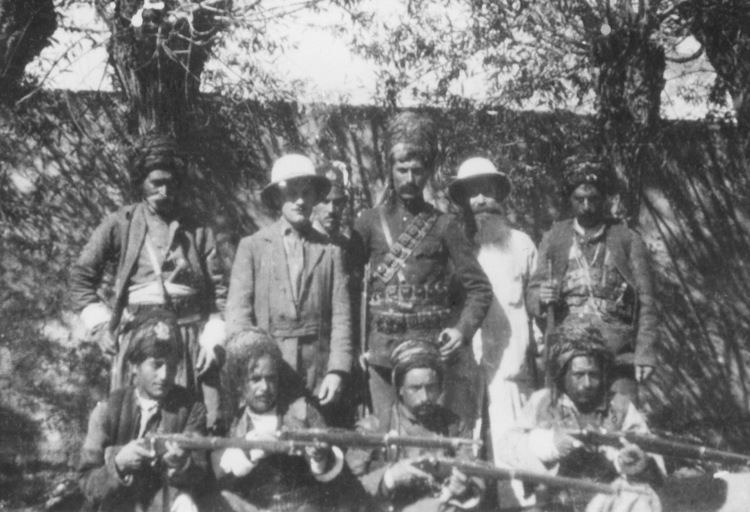
Seminar simko shikak tishktv
Family background
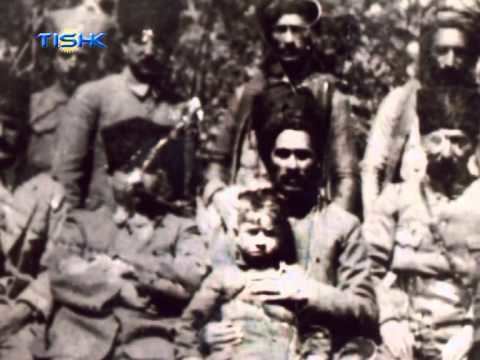
His family was one of the most prominent and politically active Kurdish families throughout Qajar reign from the late 18th to early 20th century. Sadiq Khan Shikak was one of the generals and governors in the Agha Muhammad Khan's early Qajar state and was commanding a force of 10,000 soldiers. However, he was soon fell out of favor and Qajar monarch attempted to murder him. Sadiq Khan has been accused of taking part in the assassination of Qajar king in the town of Shusha in 1797. Among other prominent members of the family are Ismail Khan The Great and his son Ali Khan, Muhammad Pasha son of Ali Khan, Cewer (Ja'afar) Agha brother of Simko. Many members of the family were murdered by the Qajar state such as Cewer(Dja'far) Agha who was killed at Tabriz by the order of governor general.
Murder of Cewer Agha

In 1905, the Qajar monarch Mozafar-al-Din Shah appointed Hussein Quli Khan Nizam ul-Saltana as the general governor of Azerbaijan. According to Iranian historian Ahmad Kasravi, Nizam ul-Saltana officially invited Cewer Agha to Tabriz in order to consult him on the border issues between Iran and the Ottoman Empire. Once Cewer Agha arrived in Tabriz, Nizam ul-Saltana ordered Muhammad Hussein Khan Zargham to invite Cewer Agha to his own residence and murder him. Cewer Agha was accompanied by seven of his guards including one of his uncles. Muhammad Ali Mirza, the Iranian Crown Prince, ordered his murder via telegraph sent to Nizam ul-Saltana. Five of Cewer Agha's guards managed to escape from the murder plot in Tabriz in a ferocious battle and return to Chari castle. Cewer's father, Muhammad Agha, sought help from Sultan Abdulhamid II in Istanbul to avenge the murder of his son. However Iranian envoy in Ottoman court managed to counter his efforts and according to some sources, Muhammad Agha was assassinated in a Qajar conspiracy in Istanbul. Murder of Cewer Agha caused outrage among the Kurds. Moreover, many Iranian intellectuals and constitutionalists in Tabriz and Tehran condemned his assassination.
Political life
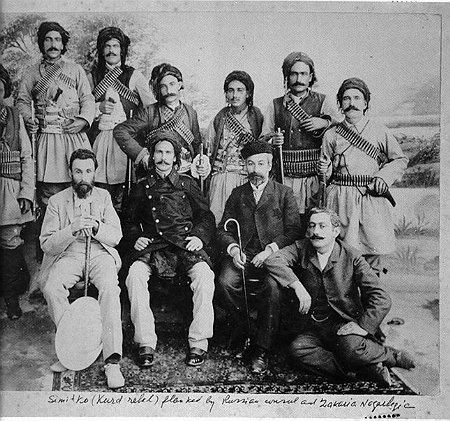
There are different and conflicting views about Simko among Kurdish historians. After the murder of Cewer Agha, Simko became the head of Shikak forces. At this time, Iranian government was trying to assassinate him like the other members of his family. In 1919, Mukarram ul-Molk, the governor of Azerbaijan, with the help of Armenians, devised a plot to kill Simko by sending him a present with a bomb hidden in it. Although the plot failed, but it revealed the intentions of the Iranian government, and propelled Simko into a turbulent period of political and military confrontation with Iran.
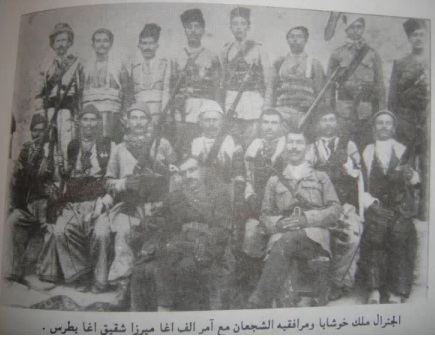
Simko was in contact with other Kurdish nationalists such as Abdurrazaq Badrkhan (Bedirxan) and Seyyed Taha Gilani (grandson of Sheikh Ubaidullah Nahri who had revolted against Iran in 1880s). Seyyed Taha was a Kurdish nationalist who was conducting propaganda among the Iranian Kurds for the union of Iranian Kurdistan and Turkish Kurdistan in an independent state. He was also aware of the international geopolitics and modern nationalism. In one of his letters to Iranian authorities, he talks about the right of self-rule and autonomy for the Kurds and compares Kurdish demands with similar demands of other nationalities in Europe.
Simko Shikak revolt
In March 1918, under the pretext of meeting for the purpose of cooperation and peace, treacherously, Simko planned and executed the assassination of the head of the Assyrian nation, patriarch Mar Shimun XXI Benyamin, ambushing him and his 150 guards as Mar Shimun was leaving the meeting and entering his carriage. After the murder of Mar Shimun, the Assyrians of Hakkari took revenge on the Muslim population of Salmas and most of the villages of Salmas County, while Simko and his men massacred Christians in Khoy.
By summer 1918, Simko had established his authority in the region west of Lake Urmia. After this, he organized his forces to fight the Iranian army in the region and managed to expand the area under his control to nearby towns and cities such as Mahabad, Khoy, Miandoab, Maku and Piranshahr in a series of battles.
At this time, government in Tehran tried to reach an agreement with Simko on the basis of limited Kurdish autonomy. Simko had organized a strong Kurdish army which was much stronger than Iranian government forces. Since the central government could not control his activities, he continued to expand the area under his control and by 1922, cities of Baneh and Sardasht were under his administration.
In the battle of sari Taj in 1922, Simko's forces could not resist the Iranian Army's onslaught in the region of Salmas and were finally defeated and the castle of Chari was occupied. The strength of the Iranian Army force dispatched against Simko was 10,000 soldiers. Simko and one thousand of his mounted soldiers took refuge in nearby Turkey, so then they were forced to lay down their weapons.
Defeat and assassination
After the murder of Shimun XXI Benyamin by Simko, Agha Petros joined forces with Malik Khoshaba and defeated Simko's forces driving Simko from his stronghold at Koynashahr. In 1930, the commander of Iranian Army General Hassan Muqaddam sent a letter to Simko, and invited him for a meeting in the town of Oshnaviyeh. After consulting with his friends, Simko along with Khorshid Agha Harki went to Oshnaviyeh and were invited to the house of local army commander, Colonel Norouzi and were told to wait for the Iranian general. Colonel Norouzi convinced Simko to go to the outskirts of the town to welcome the general's arrival. However, this was a trap and Simko was ambushed and killed on the evening of June 30, 1930.
Cultural activities
The first schools for Kurds were established in Mahabad in 1909 by international missionaries operating under the Lutheran Orient Mission. This is also where the first Kurdish periodical appeared, though it did not last long. Simko attacked the Kurdish and other inhabitants of Mahabad operating on the fringes of the Ottoman army. The schools in Mahabad recovered only when the surviving missionaries dared to return in 1920 when Simko's rampaging was being brought in check by the Iranian army. In 1912, Simko and Abdul-razzaq Badirkhan established a Kurdish journal in Iran, a monthly magazine titled Kurdistan. Moreover, he opened a Kurdish school in the north-western city of Khoy. These cultural activities were mainly organized by an association named Cîhandanî based in Khoy. From 1919 up to the end of his movement in 1922, he also published a newspaper titled Roja Kurd which was the official organ of his government in Urmia. The editor-in-chief of Roja Kurd was Muhammad Turjanizade.
